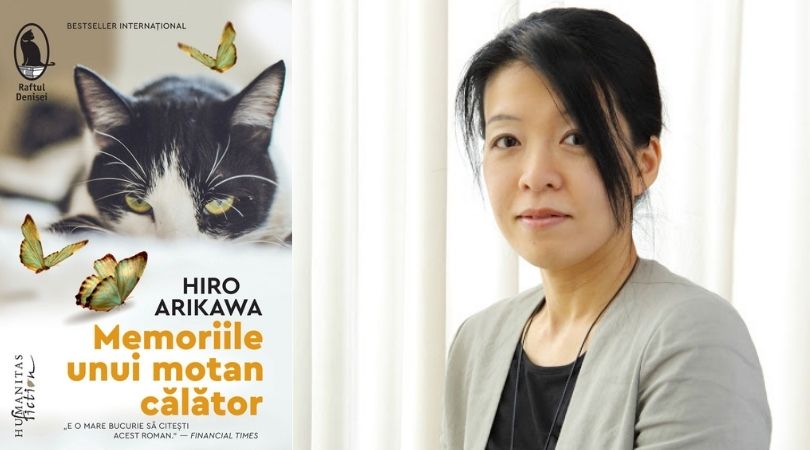„Now the cat’s meowing
Has ceased. the bedroom touched by
the rays of the moon.” (Matsuo Bashō)
Nana and Satoru resolutely set out in Satoru’s silver van. And for days on end they will travel, do new things, meet some of Satoru’s former schoolmates and Nana will catch sight of the sea for the first time. In parallel, Satoru’s past catches up on him in more ways than one and Nana comments on everything – from the people they meet or the places they visit to the things experienced first-hand – with irony, with malice or with excitement, as the case may be. A travelogue, the story of a relationship not devoid of complications, a singular personal history? Well, none of these exclusively and yet a little bit of each. Thus could be defined Hiro Arikawa’s novel, which was published in 2012 and instantly became a bestseller in Japan and in over thirty other countries. Its 2018 screen version was directed by Koichiro Miki and it was also adapted for radio theatre. The novel is entitled „The Travelling Cat Chronicles” – because, yes indeed, Nana, Satoru’s travelling partner, is a tomcat!
Therefore, from an apparently ludic experiment, Hiro Arikawa’s book becomes a subtle questioning of the realities of the contemporary world, in which people are lonelier than they would like to believe or are willing to admit, as well as a bitter meditation on the difficulty of communication within the family, on the hidden dramas of so many couples and on the unhappiness of too many children.
The Japanese have always had a fascination with cats. The Archipelago is renowned for its temples dedicated to cats and the vivid ‘maneki-neko’, the colourful auspicious images of cats with lifted paws, are to be found at every store entrance. Neither has Japanese fiction overlooked felines, as they have been depicted, since the earliest times, in the renowned literary works of this cultural space. In „The Pillow Book”, dating back to the beginning of the eleventh century, Sei Shonagon recounts how, because Emperor Ichijo had lost his beloved cat, all his subjects were obliged to look for it. And there are many cats and tomcats in the lines of Matsuo Bashō, the great master of seventeenth-century haiku. Closer to the present day, Jun’ichiro Tanizaki, member of the Subaru Group (the Pleiad), published, in 1936, the short-story „A Cat, A Man and Two Women” and, in 1905, a famous novel by Natsume Sōseki was published in no less than three volumes, more than the writer had intended to write, because the readers, captivated by the topic, could not get enough of the story. The novel, entitled „I Am A Cat”, opens with the line: “I am His Highness the Cat. As yet I have no name.” Familiar with all of these, the Japanese writer Hiro Arikawa (b. 1972) began her own novel, „The Travelling Cat Chronicles”, with a Prologue including the exact words of Sōseki’s feline protagonist! “I am a cat. As yet I have no name. There’s a famous cat in our country who once made this very statement.”
But this cat will have a name – and not just any name, but Nana, namely ‘seven’ – given to him because of the unusual form of his crooked black tail which daintily complements his white feline appearance… On the other hand, however, the writer avails herself of a series of narrative strategies and ploys adopted from the great Sōseki, because, just like the speaking cat that delighted the Japanese readers of the early twentieth century, Nana also assumes, in many parts of the text, the role of story-teller. And likewise, he is a genuine critic of the things and people he encounters. But unlike his predecessor devoid of a name, the lovely, whimsical Nana will appease his irony when he gets to know better the human beings around him and will put a serene or a nostalgic smile on the reader’s face when he recounts many of the events with an … all but feline warm-heartedness! But it is also Nana who, by the end of the novel will have brought tears to our eyes because, obviously, only a cat might have had such a keen, heart-rending perception of the world from which Satoru, his former friend and travelling companion, is now missing.
We should also bear in mind that „The Travelling Cat Chronicles” is both a unique memoir – of felines and human beings – and an extraordinary appraisal of the relations between animals and people. But it is also a travelogue. So that the apparently – and intentionally – frivolous tone at the beginning of the text is nothing but the most adequate way for Arikawa to approach her protagonists and to probe depths unforeseen on reading the text for the first time. Obviously, the style of the first chapters may seem too superficial, the events somehow predictable and the sotto voce intrusions of the tomcat slightly too learned or too elaborate for a feline, however intelligent or sensitive it might be… But, by choosing to start everything with the light touches of an anime, the author imperceptibly takes us onto the realm of the strongest feelings, of the most gripping emotions and of the deepest meanings. So what happens, in fact, in this book? Satoru, a handsome, sensitive young man who owns a silver van, adopts the stray tomcat he finds quite often dozing on his car. At first he will feed him, then he will stroke him, always nostalgic for another, similar cat called Hachi (that is, ‘eight’, as the spots on his head resembled an 8!), to which he had been deeply attached in his childhood. But, after five years happily spent together, Satoru starts thinking about the future and does his best to find Nana a new home. So they set out together, and their journey takes them from one part of Japan – the foot of Mount Fuji – to the seashore and eventually to Sapporo, on Hokkaidō Island.
With the only difference that their drive is not a leisure trip, but a journey. Satoru and Nana are not tourists, but travellers. And their travel is, undoubtedly, a rite of passage: at the end of it neither of them will be anything like the one who set out. In fact, at the end of it nothing will be the same anymore. At the same time, this journey is not just a physical tour across landmarks of Japan, but it equally plays against the reader, fragmentarily, Satoru’s entire past. Thus, the reader will find out that poor Hachi, the cat of the protagonist’s childhood, had died far from his dear little master because, years before, Satoru’s parents had died in a tragic accident and the child’s aunt – his tutor as of that moment, had refused to take in her nephew’s beloved cat. But Nana is not a second Hachi, he is Nana! He is the pal without whom, the cat is convinced, the poor young man would not be able to find his way about this world full of challenges, in which it is so hard to find a real friend… And, speaking of friends, Nana has the opportunity to meet, along this trip for two, several of Satoru’s best friends. At first Kōsuke and Yoshimine, the boy’s playing, swimming and gardening childhood companions; then Sugi and Chikako, his former high-school classmates, both of whom are now married. All of them are, of course, decent, well-meant people, otherwise they wouldn’t be his master’s friends… but, for various reasons, they are unable to take Nana into their homes, however much they would like to help Satoru. Let alone that, after every failure in his enterprise, Satoru himself concludes that… it is for the better, the owner of the silver van and his black-tail tomcat are better off together. And Nana gets to meet, alongside Satoru’s friends, some of their pets – cats and dogs – with which he obviously cannot get along. He sees horses and deer for the first time, he contemplates Mount Fuji, he is frightened by the sea waves and ecstatic at the sight of the rainbow, he intimates how big the world is and how complicated human feelings can be but, who knows why, it will be a long time, they will have travelled many miles and he will have witnessed many forays into the past to realize how fragile and vulnerable Satoru has, almost imperceptibly, become…
“So here we are at the end, but do not think I have told you a sad story! On the contrary, it has made me recount the beautiful moments of my journey only to inspire me to set out again. I hope that someday, all those who set out before me and all those who will follow afterwards will meet in this field of flowers, beyond the horizon.”
Therefore, from the apparently ludic experiment it initially seemed to be, Hiro Arikawa’s book becomes a subtle questioning of the realities of the contemporary world, in which people are lonelier than they would like to believe or are willing to admit, as well as a bitter meditation on the difficulty of communication within the family, on the hidden dramas of so many couples and on the unhappiness of too many children. A genuine book of quest – the quest for the meaning of the world and the quest for the self-, Arikawa’s text manages to keep narrative suspense in a remarkable way and to unravel only at the end of the story the reasons for Satoru’s decision to embark on a journey with Nana. And it is here that the author evinces her extraordinary narrative talent, in that she tells, largely by means of Nana’s intrusions, a story of life (and death) that would touch even the most insensitive representative of the feline or of the human world… But, with the unexpected ending, „The Travelling Cat Chronicles” also brings an incredible glimmer of hope: the hope that, at least sometimes, animals can help us overcome loneliness – and obviously, cats in particular are apt at that… Because Satoru’s aunt, Noriko, the one who rejected Hachi years ago, will now take in her nephew and his cat, Nana. Moreover, Nana will teach her how to love cats and will make her, albeit indirectly, adopt a stray cat. The last words in the book are uttered, naturally, by the matchless cat Nana: “So here we are at the end, but do not think I have told you a sad story! On the contrary, it has made me recount the beautiful moments of my journey only to inspire me to set out again. I hope that someday, all those who set out before me and all those who will follow afterwards will meet in this field of flowers, beyond the horizon.” By thus drawing the final line, Hiro Arikawa will make her readers meditate, as by now they will have become more insightful into the hidden truths of the relationships between animals and people and, moreover, of those between people. Without claiming that the journey will be a light one, but merely suggesting, by the famous quote from the Cheshire Cat in Lewis Carroll’s „Alice in Wonderland”, that there is, nonetheless, an end to the road, Nana seems to tell us, every step of the way: “Oh, you’re sure to [get somewhere] if you only walk long enough…”
Hiro Arikawa, „The Travelling Cat Chronicles”/ „Memoriile unui motan călător”, translated into Romanian and notes by Raluca Nicolae, Humanitas Fiction Publishing House, Bucharest, 2020
Translated into English by Mirela Petrașcu


























Scrie un comentariu